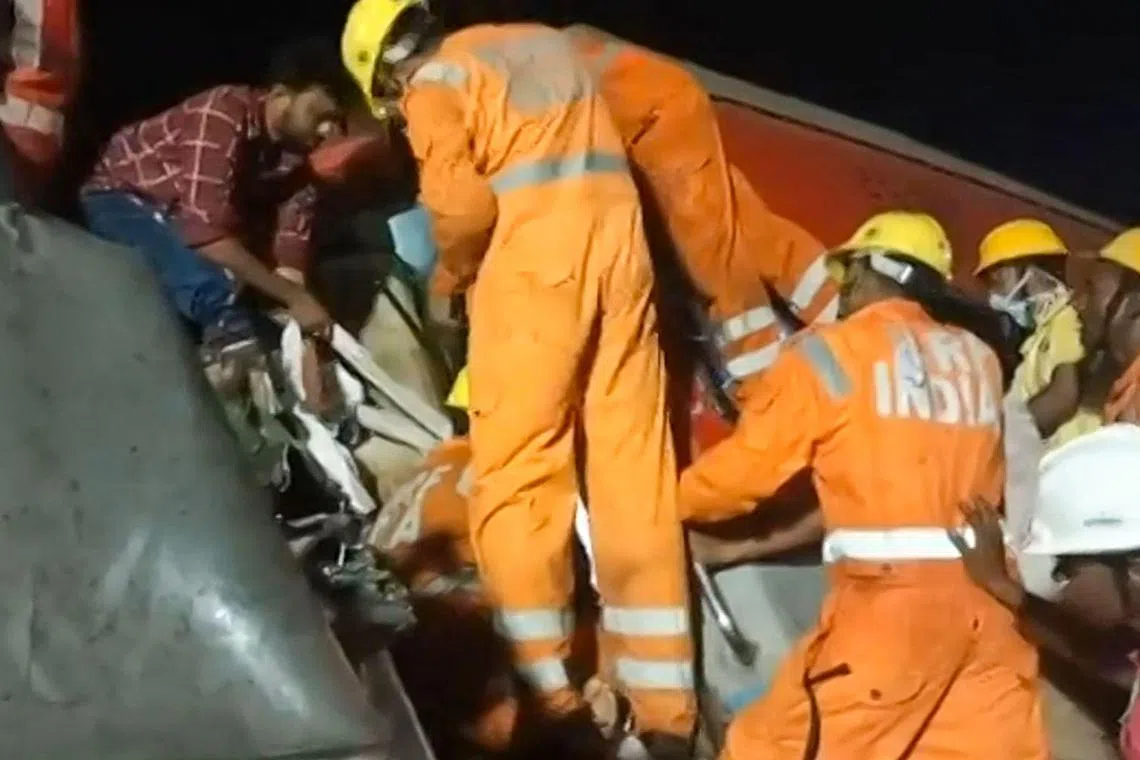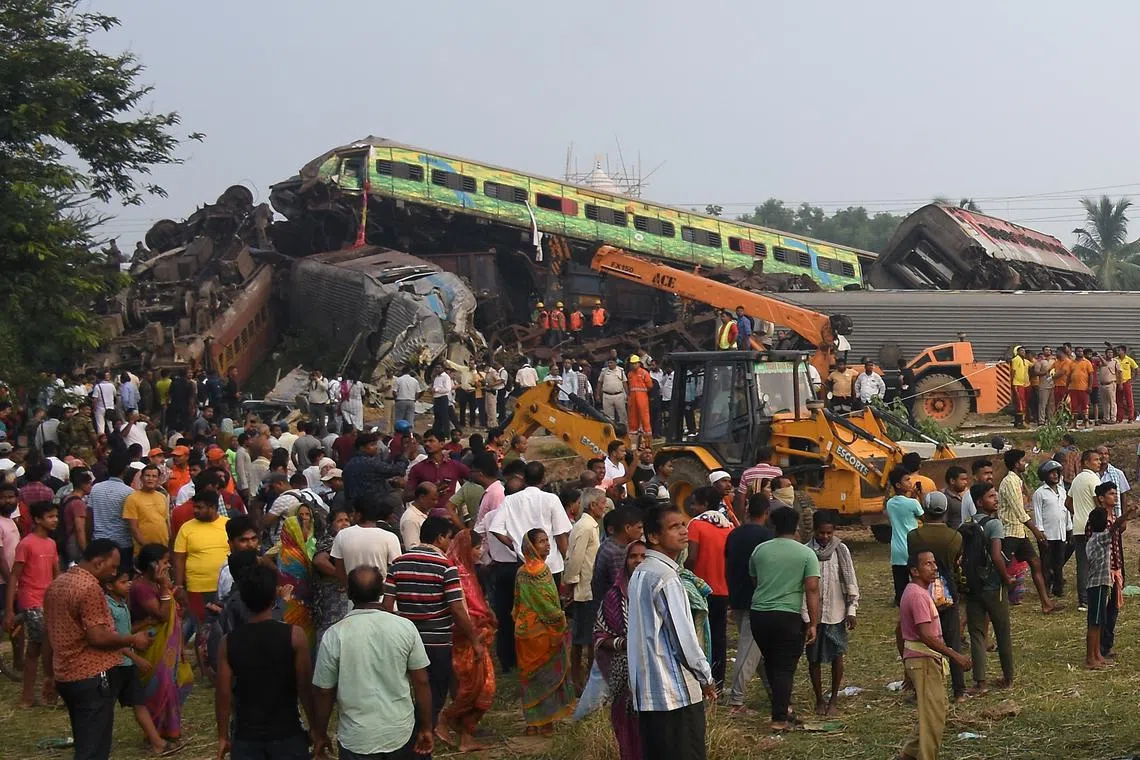India’s worst train crash in decades kills at least 288; signal error may be to blame
Sign up now: Get insights on Asia's fast-moving developments
Follow topic:
BHUBANESWAR, India - At least 288 people have died in India’s worst rail crash
One train in Friday’s accident in the district of Balasore in Odisha state, in the east of the country, also hit a freight train parked nearby, leaving a tangled mess of smashed rail cars and injuring 803.
The death toll has reached 288, said Mr K.S. Anand, chief public relations officer of the South Eastern Railway.
Bodies were still trapped in the mangled coaches and the rescue operation was continuing, a Reuters witness said on Saturday, with the death toll expected to rise.
The collision occurred at around 7pm (9.30pm Singapore time) on Friday when the Howrah Superfast Express from Bengaluru to Howrah in West Bengal collided with the Coromandel Express from Kolkata to Chennai.
A preliminary report indicated that the accident was the result of signal failure, Mr Anand said.
“The Coromandel Express was supposed to travel on the main line, but a signal was given for the loop line instead, and the train rammed into a goods train already parked over there. Its coaches then fell onto the tracks on either side, also derailing the Howrah Superfast Express,” he said.
Accompanied by officials and Railways Minister Ashwini Vaishnaw, Prime Minister Narendra Modi inspected the wreckage and told the local authorities to ensure that they provide the affected families with all the help they needed, Indian media said.
The Prime Minister also visited some survivors of Friday’s tragedy at a hospital in Balasore.
Mr Modi tweeted that he was “distressed by the train accident”.
“In this hour of grief, my thoughts are with the bereaved families,” he said. “May the injured recover soon.”
Wreckage debris was piled high at the crash site, where some carriages had been tossed far from the tracks and others flipped over entirely.
Smashed train compartments were torn open in the impact, leaving bloodstained holes in their sides.
Rescue operations at the site of the crash have been completed, a South Eastern Railway official said on Saturday.
The authorities said every hospital between the crash site and the state capital Bhubaneswar around 200km away was receiving victims, with 200 ambulances – and even buses – deployed to transport them.
Images from the crash site showed rescuers climbing up the mangled wreck of one of the trains to find survivors, while passengers called for help and sobbed next to the wreckage.

Rescue workers trying to reach trapped victims of the train collision.
PHOTO: AFP
People were seen searching for their relatives at the site and at nearby hospitals.
Video footage on Saturday morning showed police officials moving bodies covered in white cloth off the railway tracks.
“I was asleep,” an unidentified male survivor told NDTV news. “I was woken up by the noise of the train derailing. Suddenly, I saw 10, 15 people dead. I managed to get out of the coach, and then I saw a lot of dismembered bodies.”
Videos shared on social media showed the arrival of several ambulances, as well as people being pulled out of the upturned train coaches.
Surviving passenger Anubha Das said he would never forget the scene.
“Families crushed, limbless bodies and a bloodbath on the tracks,” he said.
Another witness involved in rescue operations said the screams and wails of the injured and the relatives of those killed were disturbing.
“It was horrific and heartrending,” he said.
Mr Vaishnaw said families of the dead will receive one million rupees (S$16,400), while the seriously injured will get 200,000 rupees, with 50,000 rupees for those who suffered minor injuries.

People gathering around near the damaged coaches at the accident site on June 3.
PHOTO: REUTERS
Some state governments have also announced compensation.
“It’s a big, tragic accident,” Mr Vaishnaw told reporters after inspecting the site. “Our complete focus is on the rescue and relief operation, and we are trying to ensure that those injured get the best possible treatment.”
An extensive search-and-rescue operation was mounted after the crash, involving hundreds of fire department personnel, police officers and sniffer dogs. National Disaster Response Force teams were also at the site.
Hundreds of young people lined up outside a government hospital in Odisha’s Soro to donate blood on Friday, with a medical official saying more than 3,000 units of blood were collected.

Damaged carriages are seen at the site of the collision on June 3.
PHOTO: AFP
Odisha’s Chief Minister Naveen Patnaik declared a day of state mourning on Saturday as a mark of respect to the victims.
According to Indian Railways, its network facilitates the transportation of more than 13 million people every day.
However, the state-run monopoly has had a patchy safety record because of ageing infrastructure.
Opposition Congress party leader Jairam Ramesh said the incident reinforced why safety should always be the foremost priority of the rail network.
Mr Modi’s administration has launched high-speed trains as part of plans to modernise the network.
But critics say it has not focused enough on safety and upgrading ageing infrastructure.
India’s deadliest railway crash occurred in 1981, when a train plunged off a bridge into a river in Bihar state, killing an estimated 800 people.
Friday’s crash ranks as its third worst, and the deadliest since 1995, when two express trains collided in Firozabad, near Agra, killing more than 300 people. REUTERS, AFP


